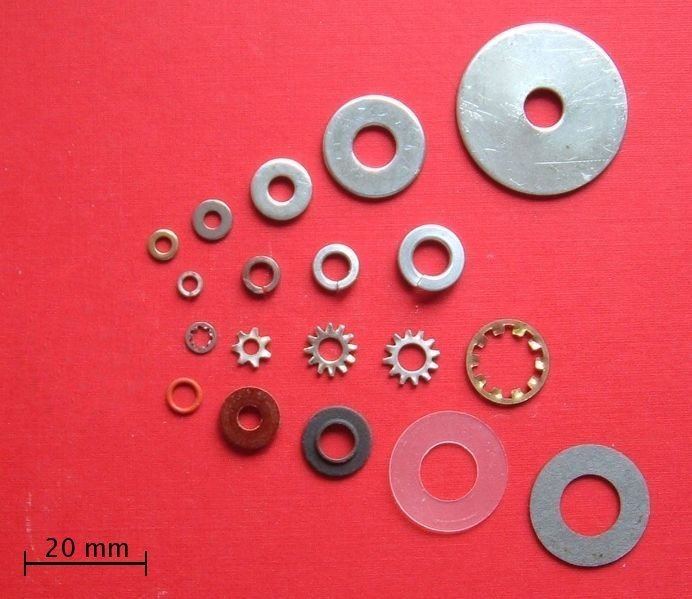 | ||
A washer is a thin plate (typically disk-shaped) with a hole (typically in the middle) that is normally used to distribute the load of a threaded fastener, such as a screw or nut. Other uses are as a spacer, spring (belleville washer, wave washer), wear pad, preload indicating device, locking device, and to reduce vibration (rubber washer). Washers usually have an outer diameter (OD) about twice larger than their inner diameter (ID).
Contents
- Type and form
- Spring and locking washers
- Gaskets
- Materials
- Corrosion resistance
- Standard metric flat washers sizes
- References
Washers are usually metal or plastic. High-quality bolted joints require hardened steel washers to prevent the loss of pre-load due to Brinelling after the torque is applied.
Rubber or fiber gaskets used in taps (or faucets, or valves) to stop the flow of water are sometimes referred to colloquially as washers; but, while they may look similar, washers and gaskets are usually designed for different functions and made differently.
Washers are also important for preventing galvanic corrosion, particularly by insulating steel screws from aluminium surfaces.
The origin of the word is unknown; the first recorded use of the word was in 1346, however, the first time its definition was recorded was in 1611.
Type and form
Washers can be categorised into three types;
The American National Standards Institute (ANSI) provides standards for general use flat washers. Type A is a series of steel washers at broad tolerances, where precision is not critical. Type B is a series of flat washers with tighter tolerances where outside diameters are categorized as "narrow", "regular" or "wide" for specific bolt sizes.
"Type" is not to be confused with "form" (but often is). The British Standard for Metric Series Metal Washers (BS4320) written in 1968 coined the term "form". The forms go from A to D for Bright Metal and denote outside diameter and thickness:
Spring and locking washers
Lock washers, locknuts, jam nuts, and thread-locking fluid are ways to prevent vibration from loosening a bolted joint.
Gaskets
The term washer is often applied to various gasket types such as those used to seal the control valve in taps. Crush washers are made of a soft metal such as aluminium or copper and are used to seal fluid or gas connections such as those found in an internal combustion engine.
Materials
Washers can be fabricated from a variety of materials including, but not limited to:
Corrosion resistance
A number of techniques are used to enhance the corrosion resistant properties of certain washer materials:
Standard metric flat washers sizes
Washers of standard metric sizes are listed in the table below. Measurements in the table refer to the dimensions of the washers as described by the drawing.
